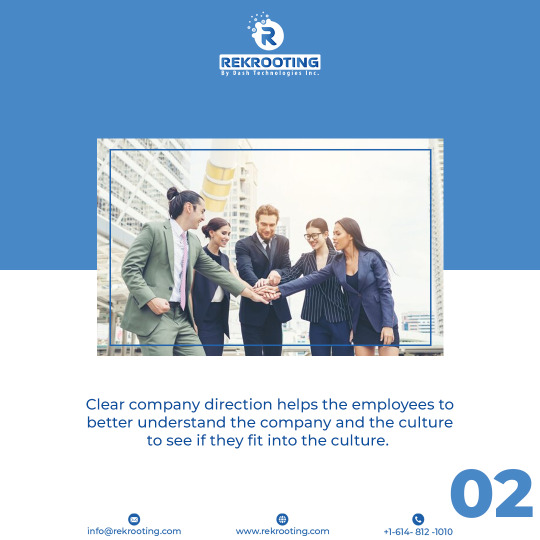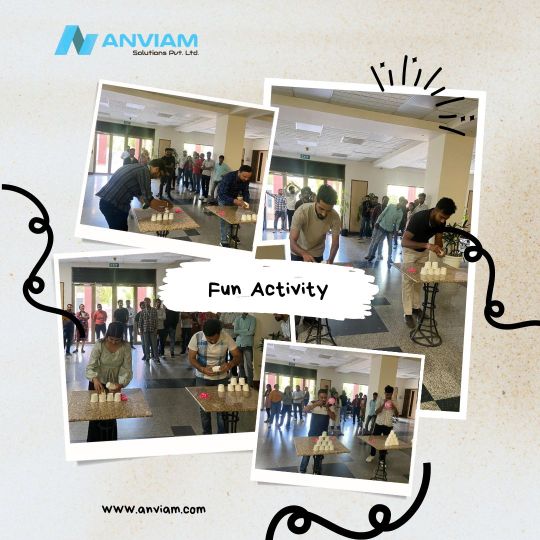#EmployeeMorale
Text






5 Ways to Improve Employee Engagement at Work
Employee engagement in companies is a measure to know how strongly the employees feel connected and motivated with the organization and the employer. Employee engagement substantially impacts productivity, morale, customer service, employee turnover, and recruitment. Check this out!
#employeeengagement #employeeexperience #employeemorale
5 notes
·
View notes
Text
The concept of forced distribution in performance evaluations is a pivotal yet contentious topic. This performance management strategy, rooted in statistical and psychological theories since the mid-20th century, involves categorizing employees into perf...
0 notes
Text
Top 5 Benefits of Using Vabro!

Explore why Vabro is the ideal choice for enhancing your project management:
Boost Productivity and Maximize ROI: Enhance your team's efficiency and achieve a higher return on investment.
Elevate Employee Morale: Happier teams lead to better outcomes.
Powered by Advanced AI: Utilize state-of-the-art artificial intelligence to optimize your processes.
Cost-Effective and Great Value: Experience premium solutions at an affordable price.
Exceptionally User-Friendly Interface: Enjoy an intuitive and seamless user experience.
🔗 Visit www.vabro.com to know more.
#Scrum#Agile#Vabro#ProjectManagement#BoostProductivity#EmployeeMorale#AdvancedAI#GreatValue#UserFriendly#MaximizeROI#BusinessSuccess#TeamEfficiency#PlanCollaborateDeliver#ProjectSuccess#AgileTools#OptimizePerformance
0 notes
Text
#beststartupstory#bss#business story#business#leadership#employeeachievement#productivity#workplaceculture#innovation#engagement#employeemorale#teambuilding#effectivemanagement#organizationalsuccess
0 notes
Text
🥳 Celebrate Success: How to Recognize and Reward Employee Achievements 🎉

In the hustle and bustle of the modern workplace, it's easy to get caught up in daily tasks and forget to take a moment to celebrate the successes of your team. However, recognizing and rewarding employee achievements is crucial for maintaining a positive workplace culture, boosting morale, and fostering long-term loyalty. Here's how to effectively celebrate success and make your employees feel valued and motivated.
🎯 Why Recognition Matters
Employee recognition isn't just a nice-to-have; it's a must-have for any thriving organization. According to a Gallup poll, companies with higher levels of employee engagement see a 21% increase in profitability. Recognizing and rewarding achievements can lead to:
Increased Motivation: Employees who feel appreciated are more likely to go the extra mile.
Higher Retention Rates: Recognition reduces turnover by making employees feel valued.
Improved Performance: When achievements are acknowledged, it encourages others to strive for excellence.
🎁 Effective Ways to Reward Your Team
Personalized Gifts: Show your appreciation with personalized gifts that reflect the individual’s interests and hobbies. This could be anything from a custom mug to tickets for a concert they’ve been dying to see.
Public Recognition: Celebrate achievements in team meetings or company-wide newsletters. Public recognition not only makes the individual feel special but also inspires others.
Career Development Opportunities: Offer opportunities for further education or professional development. This could include workshops, courses, or conferences that align with their career goals.
Extra Time Off: Reward outstanding performance with additional paid time off. A surprise long weekend can be a much-appreciated break for hardworking employees.
Monetary Bonuses: Financial rewards are always appreciated. Consider giving bonuses, gift cards, or even stock options for significant achievements.
Experience-Based Rewards: Offer experiences instead of physical gifts. Think about team outings, spa days, or adventure trips that create lasting memories.
🏆 Creating a Culture of Recognition
To truly celebrate success, recognition should be woven into the fabric of your company culture. Here are some strategies to help you build a culture that consistently recognizes and rewards achievements:
Set Clear Goals: Ensure that employees understand what success looks like in their role. Clear, attainable goals make it easier to recognize when someone has gone above and beyond.
Encourage Peer Recognition: Create a system where employees can recognize each other. This could be a simple as a shout-out board in the break room or a digital platform where colleagues can give kudos.
Consistent Feedback: Regularly provide feedback and recognition. Don’t wait for annual reviews to acknowledge great work—make it a part of your weekly or monthly routine.
Celebrate Milestones: Don’t just focus on end goals. Celebrate the small wins and milestones along the way. This keeps motivation high and shows that you appreciate all efforts.
Lead by Example: Management should model the behavior they want to see. When leaders actively recognize and reward employees, it sets a standard for the rest of the organization.
🌟 Spotlight on Success Stories
Sharing success stories within your organization can be incredibly powerful. Create a platform where employees can share their achievements and the challenges they overcame to reach them. This not only celebrates the individual but also provides valuable insights and inspiration for the entire team.
📈 Measuring the Impact
To ensure your recognition efforts are effective, track key metrics such as employee engagement scores, turnover rates, and productivity levels. Regularly solicit feedback from your team to understand what types of recognition resonate most with them and adjust your strategies accordingly.
🚀 Take Action Today
Start making recognition a priority in your workplace today. Implement some of these strategies and watch as your workplace culture transforms into one where employees feel truly valued and motivated to achieve their best.
Remember, a little recognition can go a long way in creating a happy, productive, and loyal workforce. So go ahead, celebrate success, and watch your team soar to new heights! 🎉🚀
By integrating these recognition strategies into your daily operations, you’ll not only enhance employee satisfaction but also drive your company towards greater success. Celebrate your team, celebrate their success, and celebrate a brighter future for your organization! 🌟🏆
#EmployeeRecognition#CelebrateSuccess#WorkplaceCulture#EmployeeEngagement#EmployeeAchievements#TeamMotivation#WorkplaceHappiness#RecognitionAndRewards#EmployeeMorale#PositiveWorkplace
0 notes
Text

In today’s fast-paced business environment, where the hustle culture dominates, entrepreneurs and business owners tend to adopt a grinding mentality. Working harder and for long hours is often seen as the only avenue for success. However, it’s important to note that this relentless pursuit can frequently culminate in burnout, inefficiency, and a decline in productivity, undermining the very goals it seeks to achieve.
Recent studies have indicated that productivity significantly decreases when working more than 50 hours per week, contrary to the hustle culture’s emphasis on extended hours for success. Furthermore, nearly half of all employees experience feelings of anxiety, anger, or sadness, indicating the emotional toll taken due to excessive workplace demands.
Today, we will examine the transformative solution of business coaching, which can help guide you from the exhausting hustle mentality to a more productive and fulfilling state of flow. By learning to work smarter rather than harder, coaching can help boost your business success.
Read More
#BusinessCoaching#LeadershipDevelopment#Entrepreneurship#WorkSmart#FlowState#ProductivityHacks#WorkLifeBalance#MentalWellbeing#StrategicPlanning#BurnoutPrevention#HustleCulture#ExecutiveCoaching#BusinessSuccess#Innovation#Resilience#EmployeeMorale#WellbeingAtWork#SmartWork#PersonalGrowth#CoachingForSuccess
0 notes
Text
"Boost Employee Morale and Profits: The Art of Handling Difficult Clients"
Keep your team motivated and positive during challenging situations.
Learn how to turn difficult clients into loyal customers.
Increase profits by retaining and satisfying even the most demanding clients.
Master the art of customer service for long-term business success.
Get insider tips on handling tough situations with grace and professionalism.
😊
0 notes
Text
Consequences of Poor Employee Scheduling
Poor scheduling lead to less productivity.
Poor Employee Sceduling
Employee scheduling is a critical aspect of workforce management that directly impacts the efficiency and success of any organization. When done poorly, it can have a ripple effect that touches every facet of a business. Let’s delve into the significant consequences of poor employee scheduling and how it can negatively affect…

View On WordPress
#BurnoutPrevention#ConflictResolution#EmployeeMorale#EmployeeSatisfaction#FairScheduling WorkplaceEngagement#HappyEmployees#ScheduleManagement#ShiftWork#SmoothWorkflow#TeamHarmony#WorkLifeBalance#WorkloadBalance#WorkplaceEfficiency#: WorkforceManagement EmployeeScheduling BusinessSuccess# CustomerService# EfficientOperations# EmployeeRetention# EmployeeWellbeing
1 note
·
View note
Text



Get ready to elevate teamwork with a twist! 🚀 Our team challenges are all about collaboration, creativity, and, of course, fun! Let's break barriers, ignite innovation, and bond like never before. Are you up for the challenge?
🌐www.anviam.com
#TeamChallenges#Collaboration#FunAtWork#TeamBuilding#OfficeFun#WorkplaceCulture#TeamworkMakesTheDreamWork#EmployeeEngagement#CompanyCulture#OfficeLife#TeamBonding#WorkHardPlayHard#EmployeeExperience#OfficeGames#TeamSpirit#WorkplaceWellness#EmployeeMorale#OfficeVibes#FunFriday#WorkplaceHappiness
0 notes
Text
Ninda (Slander): Cultivating a Respectful Workplace

The Guru Granth Sahib, the sacred text of Sikhism, emphasizes the importance of Ninda (Slander). It goes beyond simply avoiding gossip; it's a call to cultivate a respectful and positive work environment. In today's interconnected world, where negativity can spread quickly, Ninda offers valuable guidance for fostering trust, collaboration, and a more fulfilling work experience.
The Harms of Ninda:
Ninda, or slander, involves spreading negativity about someone, often through gossip, rumours, or unfounded criticism. It can damage reputations, erode trust, and create a toxic work environment. Here's how Ninda can be detrimental:
Reduced Morale: When negativity spreads, it can demotivate employees and create a climate of fear and anxiety.
Damaged Relationships: Gossip can damage trust between colleagues and make collaboration difficult.
Loss of Productivity: Engaging in or being around negativity can distract from work and reduce productivity.
Legal Issues: In some cases, slander can lead to legal repercussions.
The Power of Positivity:
Ninda encourages a shift towards positive communication. By focusing on the good in others and fostering a respectful atmosphere, we create a workplace where everyone feels valued and supported. Here are the benefits of a positive work environment:
Increased Morale: A positive environment boosts employee morale and satisfaction, leading to higher productivity and engagement.
Stronger Relationships: Respectful communication fosters trust and collaboration, leading to stronger relationships between colleagues.
Improved Problem-Solving: A positive environment encourages open communication and allows for better problem-solving as a team.
Reduced Stress: A workplace free from negativity fosters a sense of well-being and reduces stress levels for employees.
Practicing Ninda in the Workplace:
Here are some ways to embody the spirit of Ninda and cultivate a respectful workplace:
Think Before You Speak: Consider the impact of your words before speaking. Is what you're about to say helpful or constructive?
Assume Positive Intent: Often, perceived negativity stems from misunderstandings. Try to understand the situation and the person's intent before jumping to conclusions.
Address Concerns Directly: If you have an issue with a colleague, address it directly with them in a respectful and private manner.
Focus on the Positive: Make a conscious effort to compliment colleagues, celebrate successes, and offer encouragement.
Be a Role Model: Set a positive example by practicing respectful communication and avoiding negativity yourself.
Ninda Toolkit for a Respectful Workplace:
The Three Sieve Test: Before sharing information about someone, consider the "Three Sieve Test" attributed to Socrates. Ask yourself: Is it true? Is it kind? Is it necessary? If the answer isn't yes to all three, don't share it.
Positive Gossip: Instead of gossiping about others, make a conscious effort to spread positive stories about colleagues and their accomplishments.
Assume Positive Intent: Don't jump to conclusions about someone's motives. Give colleagues the benefit of the doubt and try to understand their perspective.
Focus on Solutions: If you witness negativity or conflict, don't just complain. Look for ways to contribute to a solution.
Be a Role Model: By consistently demonstrating respectful communication, you can inspire others to do the same.
Remember, change starts with you. By embodying the principles of Ninda, you can create a ripple effect, inspiring others to do the same. A more respectful and positive workplace benefits everyone, leading to increased collaboration, improved productivity, and a more enjoyable work experience.
The Guru Granth Sahib offers this powerful teaching:
"Speak sweetly, even in anger. Sweet speech is always pleasing."
Let these words guide your interactions and contribute to building a workplace where respect and positivity flourish.
Ninda is a continuous practice. There will be times when negativity arises. The key is to be mindful of your words and actions, and actively contribute to a more positive and respectful work environment. By following these steps and embodying the spirit of Ninda, you can create a workplace where everyone feels valued, respected, and empowered to do their best work.
#Ninda#StopGossip#RespectfulWorkplace#PositiveCommunication#Teamwork#WorkCulture#EmployeeMorale#TrustBuilding#Collaboration#SikhWisdom#WorkplaceWellness#Professionalism#EndNegativity#BeTheChange#PositiveImpact
0 notes
Text
How to Boost Employee Engagement in a Remote Work World
#communication #Employeeengagement #employeemorale #incentives #Remotework
0 notes
Text
Work Culture During Christmas
Work culture during Christmas can vary widely depending on the country and the specific industry. However, it is common for many businesses around the world to adopt a festive and celebratory atmosphere during the holiday season.

Here's a glimpse of how work culture during Christmas might look in a few different countries, along with a mention of their plans for the next year:
United States:
Work Culture: In the United States, the period around Christmas is often marked by office decorations, holiday parties, and gift exchanges. Many companies also allow employees to take time off during the holidays.
Next Year Plans: Businesses in the U.S. typically use the end of the year to reflect on their performance and set goals for the upcoming year. This may include budget planning, setting sales targets, and outlining new projects or initiatives.
Japan:
Work Culture: Christmas is not a traditional holiday in Japan, but it's becoming more popular, especially in workplaces. Companies may have Christmas decorations, and some employees exchange small gifts.
Next Year Plans: Japanese businesses often focus on the fiscal year-end, which is in March. Planning for the new year involves budgeting for the upcoming fiscal year, setting financial goals, and preparing for the start of new projects.
Australia:
Work Culture: Christmas in Australia falls during the summer, so outdoor events and barbecues are common. Many offices have Christmas parties, and there is often a more relaxed atmosphere.
Next Year Plans: Australian businesses may use the Christmas period to review their business plans and set goals for the new year. This could include financial planning, marketing strategies, and launching new products or services.
China:
Work Culture: Christmas is not a traditional holiday in China, but some businesses, especially in urban areas, may adopt Western Christmas decorations. The focus is more on the Chinese New Year celebration.
Next Year Plans: Chinese businesses often align their plans with the lunar calendar, and the Chinese New Year marks an important time for setting business goals. Companies may plan for expansion, set budgets, and outline strategies for the upcoming year.
India:
Work Culture: Christmas is celebrated in India with enthusiasm, although it is not a public holiday nationwide. Many offices decorate workplaces, exchange gifts, and organize Christmas parties. In some regions with significant Christian populations, such as Goa and Kerala, Christmas is a major celebration with festive events.
Next Year Plans: Companies in India often use the end of the calendar year to finalize budgets for the upcoming fiscal year, which typically begins in April. This includes setting financial targets, planning for expansion, and strategizing marketing initiatives.
Europe (Representative Overview):
Work Culture: Europe has a diverse range of Christmas traditions, and work culture varies across countries. In many European countries, there is a strong emphasis on taking time off during the holiday season. Christmas markets are a common feature in countries like Germany, Austria, and Switzerland, fostering a festive atmosphere.
Next Year Plans: European businesses often engage in strategic planning during the Christmas break. This includes budget reviews, market analysis, and setting goals for the new year. In some countries, companies may also align their planning with the fiscal calendar.
Latin America (Representative Overview):
Work Culture: Christmas is widely celebrated across Latin America with various cultural influences. Many workplaces hold Christmas parties, and cities are adorned with lights and decorations. In some Latin American countries, such as Mexico, the Christmas season extends to the celebration of Epiphany or Three Kings' Day in early January.
Next Year Plans: Businesses in Latin America use the Christmas period to reflect on the past year and plan for the future. This may involve budgeting for the upcoming year, setting financial targets, and preparing for new projects.
General Observations:
Common Themes: Across these regions, businesses commonly use the Christmas period for reflection, team-building activities, and expressing gratitude to employees. New year planning often involves financial assessments, goal-setting, and strategizing for the upcoming year.
Cultural Nuances: While some regions may place a strong emphasis on taking time off during the Christmas season (such as in Europe), others may blend traditional and Western celebrations (as seen in India and parts of Latin America).
Productivity Perspective:
United States:
Prospective Boost: The holiday season in the U.S. often brings a sense of camaraderie and festivity, contributing to positive morale among employees.
Challenges: The period leading up to Christmas may see a slight dip in productivity due to holiday distractions and office celebrations.
Post-Holiday Outlook: The start of the new year is an opportunity for fresh beginnings and increased productivity, fueled by renewed energy and potential goal-setting.
Germany:
Prospective Boost: Christmas markets and festivities can foster team spirit, potentially improving interpersonal relationships.
Challenges: The closure of businesses during the holidays may lead to a temporary decline in productivity.
Post-Holiday Outlook: Companies often return with a focus on new initiatives and a structured plan for the upcoming year, promoting increased productivity.
India:
Prospective Boost: Christmas celebrations can provide a break from routine, promoting a positive work environment.
Challenges: The holiday season may witness a short-term decline in productivity due to festivities and year-end distractions.
Post-Holiday Outlook: Companies in India often start the new year with vigor, setting ambitious targets and fostering a renewed commitment to productivity.
Europe (Representative Overview):
Prospective Boost: Taking time off during the holiday season can result in employees returning with increased motivation and a fresh perspective.
Challenges: Similar to the U.S., the lead-up to Christmas might witness a temporary dip in productivity.
Post-Holiday Outlook: European businesses commonly use the post-Christmas period for strategic planning, potentially enhancing productivity in the long run.
Latin America (Representative Overview):
Prospective Boost: Celebrations can contribute to a positive workplace culture, improving morale.
Challenges: Short-term distractions during the festive season may impact immediate productivity.
Post-Holiday Outlook: Planning for the new year may bring a renewed focus on productivity and efficiency.
General Observations:
Balancing Act: The challenge during the Christmas season is finding a balance between celebrating the holidays and maintaining productivity. Employers may implement flexible schedules or remote work options to accommodate both.
Strategic Planning: Many businesses use the quieter period around Christmas for strategic planning, which can set the stage for a productive and successful year ahead.
Employee Well-being: Acknowledging and accommodating the festive spirit can contribute to employee well-being, potentially translating into improved productivity in the long term.
Strategies to Leverage the Holiday Season for Business Growth
The holiday season is not only a time of celebration and joy but also a significant opportunity for businesses to boost their presence, engage with customers, and set the stage for success in the coming year. With careful planning and strategic initiatives, companies can harness the festive spirit to maximize their impact.

Here's a detailed guide on how businesses can take advantage of the holiday season for optimal growth:
1. Festive Marketing Campaigns: Spreading Cheer Through Branding
Decorate Your Brand: Infuse your brand with the holiday spirit by updating your website, social media profiles, and marketing materials with festive visuals and messaging. Incorporate seasonal colors and elements to resonate with the holiday ambiance and capture the attention of your audience.
Limited-Time Offers: Create a sense of urgency and excitement by designing special promotions and discounts tailored for the holiday season. Consider bundling products or services to encourage larger purchases. Communicate the exclusivity of these offers to instill a sense of urgency among your customers.
2. Engage Your Audience: Building Connections in a Festive Atmosphere
Social Media Engagement: Harness the power of social media to connect with your audience during the holiday season. Run engaging contests, polls, and giveaways with holiday themes. Encourage user-generated content by inviting your audience to share their holiday experiences and interact with your brand.
Email Marketing: Craft personalized and engaging holiday-themed emails for your subscribers. Share exclusive offers, festive greetings, and express gratitude for their support. Leverage segmentation to tailor messages based on customer preferences and behavior, creating a more meaningful connection.
3. Employee Engagement: Fostering Team Spirit for Productivity
Holiday Team Building: Boost team morale by organizing virtual or in-person holiday celebrations. Whether it's a virtual party, a gift exchange, or festive decorations in the office, acknowledging and appreciating your team's hard work can enhance employee engagement.
Flexible Work Schedules: Demonstrate flexibility by offering adjustable work schedules or remote work options during the holiday season. This not only accommodates personal commitments but also ensures that work tasks are efficiently managed.
4. Strategic Sales Planning: Maximizing Revenue Opportunities
Inventory Management: Analyze past data to predict popular products during the holidays and ensure your inventory is well-stocked. Introduce exclusive holiday-themed products to attract attention and meet the increased demand.
Collaborations and Partnerships: Explore collaborations with other businesses for mutual promotional benefits. Cross-promotional campaigns or joint product offerings can expand your customer base and introduce your brand to new audiences.
5. Customer Appreciation: Building Loyalty Through Gratitude
Loyalty Programs: Introduce or promote loyalty programs during the holiday season. Reward customer loyalty with exclusive discounts, early access to sales, or special perks. Make customers feel appreciated for choosing your brand.
Express Gratitude: Go the extra mile by sending personalized thank-you notes, small gifts, or holiday cards to your customers. This personal touch strengthens the relationship between your brand and its customers, fostering loyalty.
6. Strategic Planning for the New Year: Setting the Stage for Success
Reflect and Plan: Take advantage of the slower pace during the holiday season to conduct a thorough review of the past year's performance. Identify successes, challenges, and areas for improvement. Set clear goals and strategies for the upcoming year.
Employee Training: Invest in the development of your team by providing training opportunities during the holiday season. Equip your employees with the knowledge and skills needed for the challenges and opportunities in the coming year.
7. Community Engagement: Making a Positive Impact Beyond Business
Charitable Initiatives: Align your brand with social responsibility by initiating or participating in charitable initiatives. Organize donation drives, support local charities, or contribute to community projects. Communicate these initiatives to showcase your commitment to social causes.
Local Events Sponsorship: Enhance your brand visibility by sponsoring or participating in local holiday events. This not only serves as a marketing opportunity but also fosters a sense of community engagement, showing that your business is an active and supportive part of the local scene.
About Global Launch Base:
Global Launch Base helps international startups expand in India. Our services include market research, validation through surveys, developing a network, building partnerships, fundraising, and strategy revenue growth. Get in touch to learn more about us.
Contact Info:
Website: www.globallaunchbase.com
LinkedIn: https://www.linkedin.com/company/globallaunchbase/
Email: [email protected]
#FestiveWorkplace#EmployeeEngagement#HolidayCelebrations#TeamBuilding#OfficeTraditions#StrategicPlanning#ProductivityBoost#EmployeeMorale#SeasonalDecorations#WorkplaceJoy#Collaboration#CorporateCelebrations#ProfessionalismAndCelebration#YearEndReflection#StrategicInitiatives#FestiveAtmosphere#EmployeeAppreciation#CorporateCulture#HolidaySpirit#NewYearPlanning
0 notes
Text
The concept of forced distribution in performance evaluations is a pivotal yet contentious topic. This performance management strategy, rooted in statistical and psychological theories since the mid-20th century, involves categorizing employees into perf...
0 notes
Text
Employee Burnout Solution | The Role of Constant Feedback in Companies | Lanteria HR

In this insightful video, we explore a powerful employee burnout solution - the role of constant feedback in companies. Discover how continuous feedback practices can effectively combat burnout, improve employee morale, and drive overall organizational success. Join us as we delve into Lanteria HR's cutting-edge feedback tools and strategies that can revolutionize your company's approach to employee engagement and well-being.
#EmployeeBurnoutSolution#ConstantFeedback#EmployeeEngagement#WorkplaceWellbeing#LanteriaHR#ContinuousImprovement#EmployeeMorale#FeedbackCulture#HRInnovation#OrganizationalSuccess
0 notes
Text

Appreciation matters! 81% of employees consider leaving due to lack of recognition. Show gratitude, boost morale, and retain your top talent. It's time to celebrate and appreciate your team!
#EmployeeAppreciation#RetentionStrategies#EmployeeMorale#EmployeeRecognition#AppreciationCulture#RecognitionProgram#MotivatedEmployees#SpectrumTalentManagement#SpectrumTalent
1 note
·
View note
Link
Making your employees feel important helps keep your company on top of the industry. Read here to discover why you should show worker appreciation.
0 notes